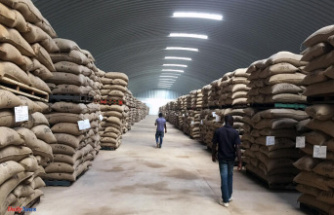Farmers like Kessel around the world are considering whether they should change their planting patterns or grow more wheat this spring, as war has slowed down or made it difficult to obtain grain supplies from the region known as .
Ukraine and Russia account respectively for one third and two thirds of the global wheat and barley exports. These countries are vital to feeding millions of people in the Middle East, Asia, and Africa who rely on cheap bread and noodles. They are also the top exporters of sunflower seed oil and other grains used in cooking and food processing.
Kessel stated that he might plant more wheat to ride the wave of high prices, which have risen by a third since the invasion. This will help offset losses due to drought and the rising cost of fuel. However, not much.
"Honestly, it will probably help us plant a few additional wheat acres. Kessel, who is also the first vice president of North Dakota Grain Growers Association, said that we will plant a few acres more wheat and some sunflowers.
The major grain producers, including the United States, Canada and France, are being closely monitored to determine if they can rapidly ramp up production to replace the Russian and Ukrainian supplies. However, farmers face the possibility of another year in drought, rising fuel and fertilizer prices, and disruptions to supply chains due to the COVID-19 pandemic. Factors like legal restrictions on exports or changes in farming practices are also a problem for major producers.
This creates uncertainty for countries such as Egypt, Pakistan, Iran and Ethiopia that can't grow enough wheat, barley or other grains to meet their demands. In countries that depend on cheap grain imports, the war has created uncertainty and food shortages.
The International Grains Council stated in its March report that any additional grain exports from any part of the world "will likely only partially compensate lower Black Sea shipping over the remainder of this season."
Ukraine accounts for half of the grain that the World Food Program purchases to feed its 125 million beneficiaries. The double threat of high food prices and low wheat exports due to the war is a recipe that could lead to "catastrophe not only in Ukraine but globally," warned the head of U.N. Food Assistance Agency.
"It will affect millions and millions, especially in the poorest parts of the world," WFP Executive director David Beasley said to The Associated Press last week in Lviv, Ukraine. He was visiting a refugee centre where food aid was distributed.
Unanswered questions surround how Western sanctions against Russia (the world's largest wheat exporter) could impact its grain exports, distribution networks, and other aspects. Russia is the largest exporter of fertilizer while Ukraine imports large quantities of corn, rye and millet. The Black Sea region is the largest producer of grains that feed livestock around the world.
Australia and India have both responded by increasing their grain exports. However, there is not enough room for other countries to do so immediately. Arnaud Petit (executive director of the International Grains Council) said that this is mainly due to persistent drought.
For the 2021-2022 season, approximately 44 million tonnes of wheat were produced in the United States. It was more than 50 million tonnes just two-three years ago. Petit referred to drought, and farmers switching to more lucrative crops.
Canada, Argentina, and Australia may try to increase wheat production for the season that ends in mid-2023. However, it's too early at this stage to know if farmers are shifting their planting patterns to more wheat-based crops.
Doug Martin stated that it is too late to make major changes to the current crop on his Manitoba farm. Plus, there are more risks when you grow a variety of crops.
Martin stated, "Most producers have an idea of what they are seeding and will likely stick to it."
Farmers will see higher earnings from wheat, but that's not enough to encourage them to increase production. Prices are rising for other crops, such as oats and canola.
Martin said that there are many other crops that will yield good returns.
Increasing production means higher supply costs. Fuel prices have risen dramatically, and the cost for fertilizer has soared due to a shortage in natural gas. This was acutely felt in Europe.
"With cheaper fertilizers it could have been possible for us to grow our way out from a global food shortage problem -- possibly," stated Sylvain Charlebois of Dalhousie University, Canada, who is a professor in food distribution policy and policy.
Philippe Dutertre cultivates wheat in Chemire-le-Gaudin in the Sarthe agricultural area, 210 km (130 miles) south of Paris. Given the rising energy and electricity prices, he hasn't made a decision to increase his wheat crop.
He said, "We might be capable of acting a bit on the crop rotation but today, France produces wheat and corn for oils and other cereals." "We don’t have the confidence to guarantee that France and Europe will have food security tomorrow," he said.
Australian farmers enjoyed a bumper wheat harvest. The agriculture department states that Australia won't be able immediately to meet lower supplies from Ukraine because it has already sold its exports to September.
Similar conditions are found in Argentina, another important grain exporter. The country has sold 95% of its wheat crop.
Jorge Josifovich is the owner of farmland in Pergamino in Argentina. This area is one of Argentina's most productive agricultural areas. He grows wheat, corn, and soybeans. Despite higher wheat prices, he stated that Argentine farmers may not be motivated to plant more due to high fertilizer and fuel cost, as well as "a strict price control imposed government that is unfavorable for producers who export their production."
This calculus makes the world's largest wheat importers, such as Indonesia, Egypt and Pakistan, as well as war-torn Yemen, cash-strapped Lebanon, vulnerable. These are countries that have large populations of people living in poverty and who rely on wheat to provide their food.
According to the Gro Drought Index , the drought in the Middle East has reached its highest level for at least 20 years. This is hindering efforts to increase domestic wheat production.
Unrest is possible if the prices rise further, especially in countries that don't have enough wheat stocks. They might have to wait for it to be available on the market, or switch to rice from their wheat reserves.
Egypt is the largest wheat importer in the world. The government recently set price caps for unsubsidized bread, and fines for those who violate them, as a response to rising prices.
Petit, of the International Grains Council, stated that there are 278 million tonnes of wheat in the world to buffer shortages caused by Ukraine. The other half of the stock is held in China, where there are more than a year of supplies to ensure food security for its 1.5 billion inhabitants.
Farmers around the world are also making hard decisions. Tom Bernhardt, a fifth-generation farmer and rancher near Linton, North Dakota, stated that no-till farmers such as himself will not alter their regular rotation or plant more wheat, because this can cause problems with soil health, and weeds.
There is no guarantee that wheat prices will remain high.
The 61-year old American farmer stated that he has never added acres to try and get a higher price.












